

GEM 2004 Report
The thirteenth Gaseous Electronics Meeting (GEM XIII) was held again at the luxurious Murramarang Ecotourism Resort this year during 1st to 5th of February. The resort is located in the pristine Murramarang National Park 18kms north-east of Bateman's Bay on the south coast of New South Wales.
SUNDAY
The CPL crew (Brian James, Neil Cramer, Sergey Vladimirov, Alex Samarian, Kostya Ostrikov, Darren Engwirda, William Tsang, and I), along with 13 other staff and students from the University of Sydney (USYD) plasma group, departed from the university on the Sunday morning and arrived at the resort after 4 hours drive.
The natural environment of the conference resort was breathtaking. The resort was surrounded by seemingly endless beaches and bush-walking trails. Our staff and students were individually taken to their accommodations. Since the resort was situated inside the national park, our accommodations were surrounded by some of the unique flora and fauna of Australia. The atmosphere was really relaxing and comfortable. And unlike last GEM conference where we had constant raining, this year the weather seems nice and fine.
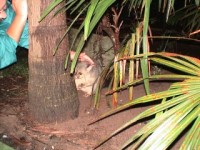
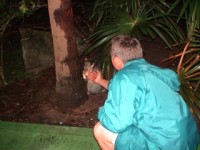
Fig. 1 & 2: Alex getting to know some of the locals living at
the national park.
Dick Morrow of Morrow Corona Solutions, Richard Mildren of Macquarie University, and Tony Murphy of CSIRO were the organizers for the GEM conference this year. At 6pm, the welcoming reception for the conference commenced. Beer and soft drinks were served and everyone caught up with everyone. USYD and Australian National University (ANU) were the two larger plasma groups which attended this year. Internationally, people from USA, Italy and Japan attended also.
This year the official GEM conference package given included 2 program booklets, name tag, a pen, a notepad, a calendar and some promotional pamphlets.
MONDAY
Alex told me in the morning that he caught a fish on the beach last night. So he planned to cook the fish at night. On the other hand, William managed to catch an eel so that was encouraging.
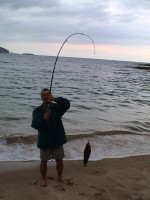
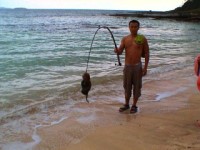
Fig. 3 & 4: Alex caught a ling and William
caught a sea eel.
The conference started early at 8.30am right after breakfast. Our chairman Dick Morrow gave his opening remarks for the GEM conference. This was followed by presentations of a number of speakers including our invited speaker, Mark Kushner from the University of Illinois, on "Optimizing plasma processing from $0.05/sq m to $1000/sq cm. There were 16 talks today. I was the first one from CPL to give a talk on "Dust cluster rotation in magnetised plasma" which was in the late noon session.
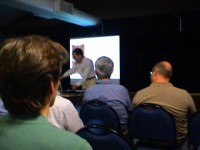
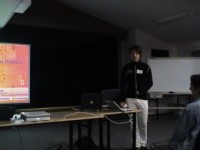
Fig. 5 & 6: Our invited speaker Mark Kushner gave
his talk in the morning. I gave mine in late noon.
Unfortunately, sad news came before the late noon session commenced. Dick Morrow informed us that our invited speaker, Raoul Franklin from the Open Oxford University, was not able to make it to the conference because his wife died in a car accident. When the news broke, everyone was shocked and Dick was especially moved. Flowers have been sent to Raoul as an expression of our sympathy to the tragedy.
Despite the sad news, my talk was well received from the audience. When the talks were over at 6pm, Alex and William went fishing. This time they did not catch anything as it started to rain. But anyhow Alex got hold of some olive oil, aluminum foil and table salt so he went to cook the fish he caught yesterday night.
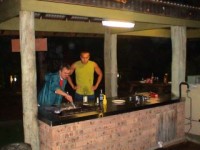
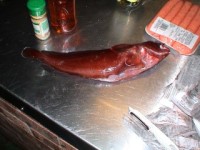
Fig. 7 & 8: Alex and William got together with
other colleagues to cook fish and sausages for dinner.
TUESDAY
The whole day today was dedicated to the "Italian - Australian Specialist Workshop on Plasma Treated Materials". So the talks were mainly on plasma processing. Some of our staff went to explore the nearby coastline and did bush walking instead (I won't name names). At night, we were given a formal conference dinner in the Chelluanna Restaurant inside the resort. Local Australian red and white wines were served.
After the conference dinner in the evening, the ANU people put up a spectacular show for us. Dick Morrow gave a short introduction speech which initiated the show for the night. And then the funny John Lowke from CSIRO gave an entertaining speech on the “history of GEM”.
Next, Christine Charles (keyboard), Orson Sutherland (violin) and Rod Boswell (guitar) formed a band of trio and performed 2 musical pieces called "Blue Bossa" and "Autumn Leaves". Vicky Au performed 2 very sexy songs for us – “My Favorite Things” from the Sound of Music and “Fever”. “Le Magicien du Lac” - Albert Meige, the French magician, then performed a live magical show for us. Everyone was impressed by the magic show as it is rare to see professional magician who does plasma physics as well. Christine then performed another solo and sang a french song called "La Boheme". Just when we thought the show has reached its climax, Rod dressed in scuba-diving gears and women stockings returned while Christine applied lime jelly on him (yes, it looked as strange as it sounds). The show was very well organized and was filled with fun and surprises.
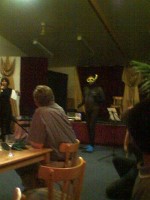
Fig. 9: Rod Boswell in his women stockings and
scuba diving gears.
WEDNESDAY
We had another busy day today. 18 talks in total were given. Both Alex Samarian and Darren Engwirda gave their talks in the morning while Kostya Ostrikov gave two talks in the afternoon and another in the evening.
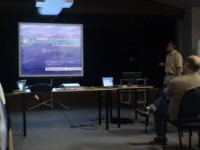
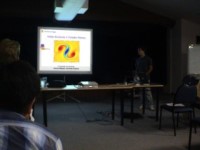
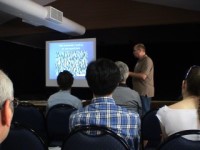
Fig. 10, 11, & 12: Our CPL crew Alex, Darren
and Kostya gave their presentations on wednesday.
The most memorable and intriguing talk was by our invited speaker, John Lowke from the CSIRO, on "The physics of lightning". In his talk, he explained physical phenomena such as "stepped leaders", "ball lightning", and the optimum placement of lightning rods. For people who are not familiar with the idea, "ball lightning" is a glowing sphere of light occasionally seen during thunderstorms which lasts up to 10 seconds and moves at about walking speed a few meters above the ground. There have been several observations within airplanes in the air during thunderstorms as well.
Lowke proposed that such phenomenon is similar to electric corona. For ground-based ball lightning, the plasma is sustained by electric fields produced from dissipating electric charges in the ground after a lightning strike. Within an airplane, similar corona phenomena could be produced due to the very high electric fields within thunderclouds penetrating the radome of the cockpit. Alex suggested to Lowke that in reality, we have water droplets and particulates in the air. So maybe the use of classical plasma physics is not sufficient to understand the origin of the ball lightning. Models using complex plasma maybe more appropriate.
In the evening, Aussie barbeque with an array of sausages, steaks, pork chops and chickens were served. Our international guests got the opportunity to experience the authentic taste of Australian outback cooking.
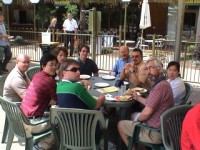
Fig. 13: The USYD plasma group got together for
the evening BBQ.
THURSDAY
The first talk in the morning was very interesting as our invited guest, Leon Allen from Davies Collison Cave Solicitors, gave us a talk on innovation patent (IP) in plasma technology. The basic idea he expressed was that scientists should protect their intellectual property assets and implement programs to secure their rights in various stages of discovery and development. Since we compete in a global market, international IP would be the obvious way to ensure the monopoly in the business market. However, the cost involved is high and the time needed for the technology to become commercially available might be relatively long compared to the 15 years of patent protection granted. Moreover, the patent applicants must share their know-how by providing a full description of how their invention works to the public. Therefore whether a certain technology should be patented or not is largely dependent on its profitability. Moreover the geography of the international patent should be market-oriented.
Kostya gave his fourth talk in the morning and William Tsang gave his in the afternoon. There were 13 talks in total today.
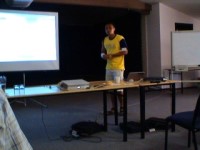
Fig. 14: William gave his presentation despite his
injuries from his bike accident.
The best student presentation prize was awarded to our student, Darren Engwirda. He was given a certificate and $250 prize money proudly supported by Coherent Scientific. The judges also gave special mentions to three other students Luke Ryves (University of Sydney), Katherine Newton-McGee (University of Sydney), and Vicky Au (Australian National University).
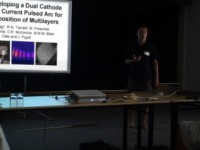
Fig. 14: Luke from USYD received special mentions
from the judge panel for his presentation.
The conference was ended with an announcement that our Head of School, Brian James, will be the organizer for the next GEM conference in 2006. Everyone gave their last minute farewells and congratulations to the people they got to know from the conference. Our Sydney crew then left the resort at approximately 1pm.
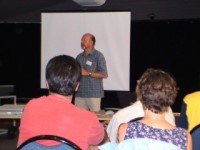
Fig. 15: Brian James will be the organiser for the
next GEM in 2006.
13/02/2004



FastCounter by bCentral